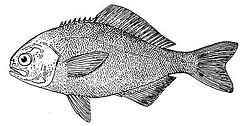| Barrelfish | |
|---|---|
 | |
| Scientific classification | |
| Kingdom: | Animalia |
| Phylum: | Chordata |
| Class: | Actinopterygii |
| Order: | Scombriformes |
| Family: | Centrolophidae |
| Genus: | Hyperoglyphe |
| Species: | H. perciformis |
| Binomial name | |
| Hyperoglyphe perciformis (Mitchill, 1818) | |
Hyperoglyphe perciformis, the barrelfish is a primarily bathypelagic species of ray-finned fish belonging to the family Centrolophidae. [2] The barrelfish is found in the Northern Atlantic Ocean. Despite being in the medusafish family, the barrelfish does not associate with jellyfish or other medusae. It is considered a deep-water gamefish. [3]


